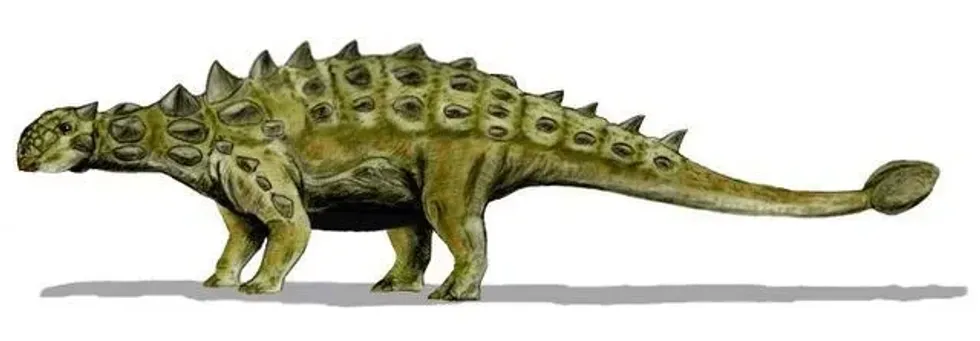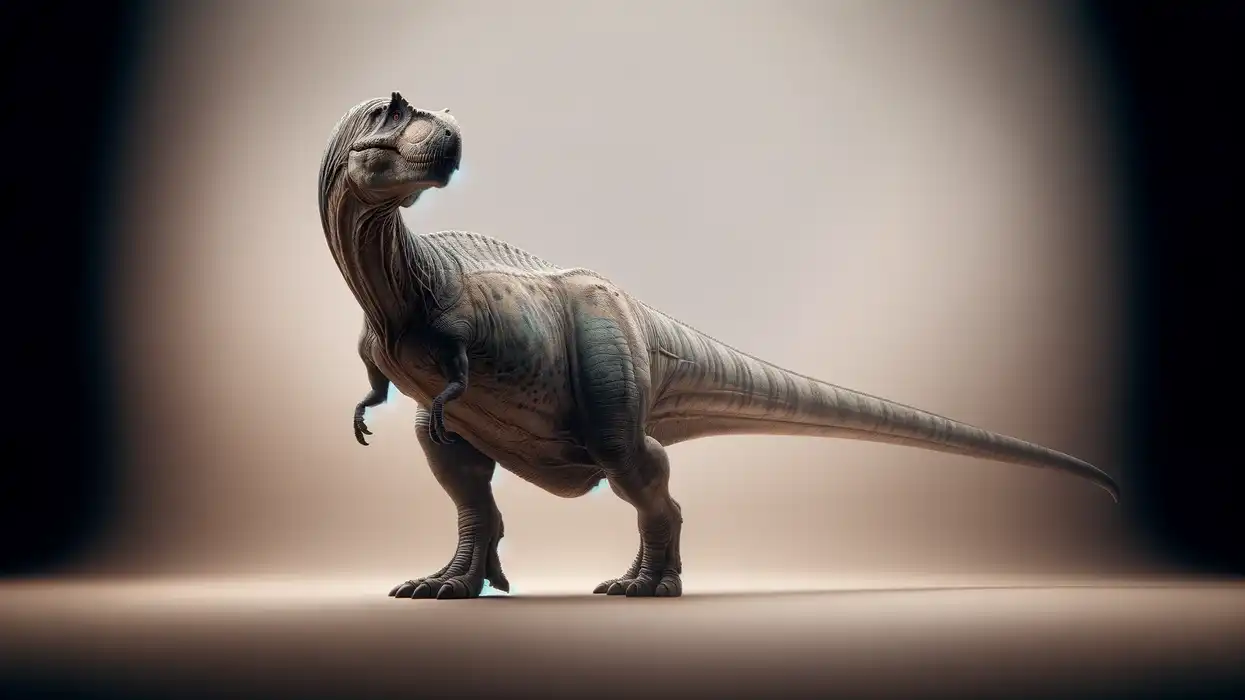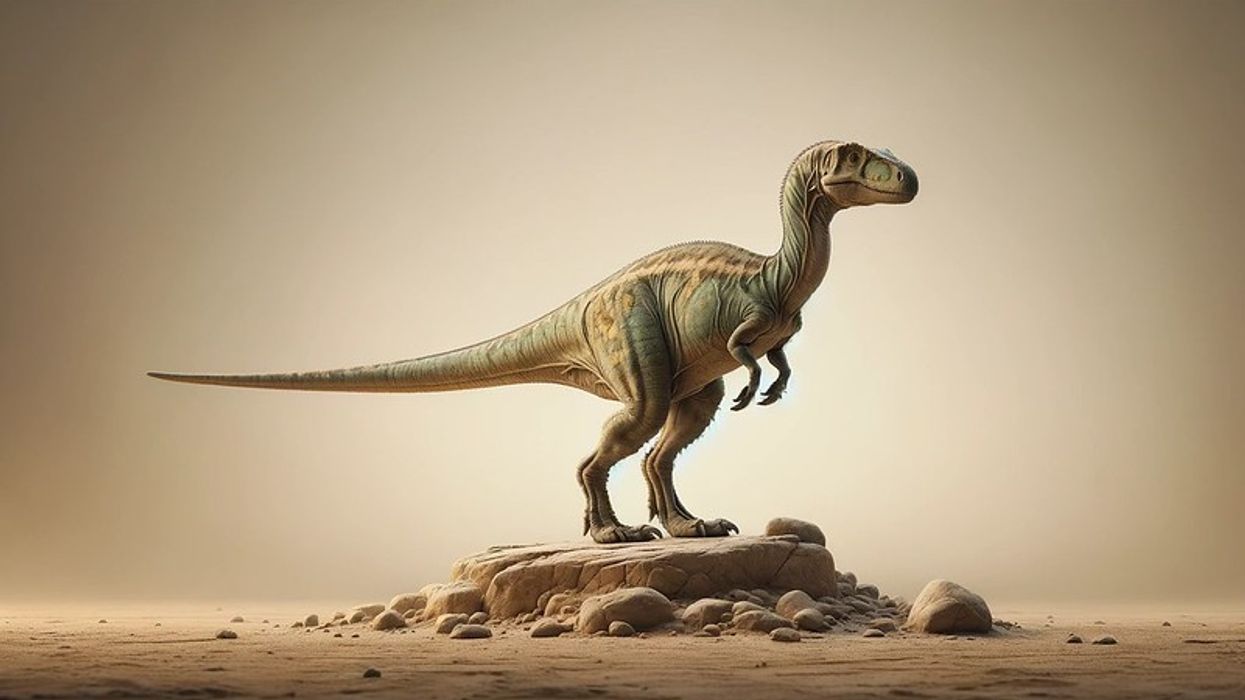Scolosaurus is an extinct genus of ankylosaurid dinosaurs that was a member of the family Ankylosauridae and the subfamily Ankylosaurinae. The fossils of this Campanian Late Cretaceous extinct genus creature have been discovered in the Dinosaur Park Formation and Oldman Formation in Alberta, Canada.
This genus comprises only two species: Scolosaurus cutleri, and Scolosaurus thronus, which are the oldest known ankylosaurid dinosaurs of North America. They are assumed to have existed in the Campanian stage of the Late Cretaceous in the Dinosaur Park Formation.
The name of this genus was given in 1928 by Franz Nopsca and means pointed spike lizard. The dinosaurs of this genus belong to the order Ornithischia.
The ankylosaurid dinosaurs are estimated to have attained a length between 19.6-21.3 ft (6-6.5 m) and weighed 4,000 lb (1800 kg). They are thought to have been medium in size, possessing a clubbed tail and thick skin, along with bony armor plates. Their diet comprised plant-based material.
A study by Currie and Arbour in 2013 had suggested that the genus Oohktokia is Scolosaurus's junior synonym.
Keep reading to discover fun Scolosaurus facts about its diet, range, appearance, and more!
If you enjoyed reading our Scolosaurus facts, you must check out our dino-mite Thalassodromeus facts for kids and Cearadactylus interesting facts!
Scolosaurus Interesting Facts
How do you pronounce 'Scolosaurus'?
Scolosaurus is pronounced as 'sko-low-sore-us'. The name of this genus means 'pointed stake lizard' and originates from the Greek terms 'skolos' and 'sauros'.
What type of dinosaur was a Scolosaurus?
Scolosaurus is a Campanian Late Cretaceous genus of the order Ornithischia, which includes two species of ankylosaurid dinosaur, Scolosaurus cutleri, and Scolosaurus thronus.
In which geological period did the Scolosaurus roam the earth?
They lived in the Campanian stage of the Late Cretaceous period approximately 76.5 million years ago in present-day Alberta, Canada, and Montana, USA.
When did the Scolosaurus become extinct?
This Late Cretaceous dinosaur of the genus of ankylosaurid is believed to have gone extinct 70.6 million years ago!
Where did a Scolosaurus live?
Scolosaurus fossils have been discovered in the Dinosaur Park Formation, Alberta, Canada, and Two Medicine Formation, Montana, USA .
What was a Scolosaurus' habitat?
Scolosaurus was a herbivorous dinosaur that lived in the warm subtropical or temperate, semi-arid climate of the present-day USA and Canada.
Who did a Scolosaurus live with?
It is not known who these dinosaurs lived with. However, it is assumed that their short legs and tank-like bodies did not allow them to walk for long distances in herds, suggesting that they probably lived in a restricted range and were solitary. We know that they co-existed with the Aralosaurus, Hadrosaurs, and Tyrannosaurus during the Cretaceous period.
How long did a Scolosaurus live?
The lifespan of this dinosaur is not yet evaluated. However, ankylosaurids are estimated to have lived for up to 64 years!
How did they reproduce?
These Cretaceous period dinosaurs are known to have reproduced through eggs.
Scolosaurus Fun Facts
What did a Scolosaurus look like?

The appearance of the Scolosaurus is estimated through an almost complete skeleton specimen that was excavated from Alberta, Canada, but did not include a skull. It is believed to have been an ankylosaur of medium size that had thick skin.
This thick skin had osteoderms (bony armor plates) that provided protection to this dinosaur from predators. Its clubbed tail also provided defense against predators like Tyrannosaurs. These creatures ranged between 19.6-21.3 ft (6-6.5 m) in length and are assumed to have reached a weight of 4,000 lb (1800 kg).
How many bones did a Scolosaurus have?
The total number of bones the Scolosaurus possessed is not known. The skeleton excavated was almost complete but lacked the tail's distal end, the right hindlimb, the right forelimb, and the skull.
How did they communicate?
Ankylosaurs had elongated respiratory tracts that could have been utilized to produce sounds to communicate with one another. It is assumed that they made low-frequency sounds with their long necks and long respiratory tracts.
How big was a Scolosaurus?
Estimating from the specimen excavated, which did not include a skull, this dinosaur is assumed to have attained a length ranging between 19.6-21.3 ft (6-6.5 m). They are slightly smaller than the Aublysodon dinosaurs that ranged between 22.9-26.2 ft (7-8 m) in length!
How fast could a Scolosaurus move?
Ankylosaurs moved quite slowly at an estimated speed of 6 mph (9.6 kph)
How much did a Scolosaurus weigh?
It is estimated that this dinosaur weighed 4,000 lb (2 tons).
What were the male and female names of the species?
The suffix of the term dinosaur is saurus for males and saura for females.
What would you call a baby Scolosaurus?
The baby of Scolosaurus dinosaurs can be referred to as a hatchling or juvenile.
What did they eat?
These mighty creatures were herbivores and fed upon plant material only. They were preyed upon by larger dinosaurs like the Tyrannosaurus!
How aggressive were they?
These dinosaurs did not prey upon other animals and are believed to have not been as aggressive as other huge dinosaurs. However, they were quite large and had thick skin that with armor plates and a clubbed tail which suggests that they were great at protecting themselves.
Did you know...
The species Euoplocephalus tutus and Scolosaurus cutleri were initially synonymized. However, Scolosaurus possessed different cervical armor and was thus distinguished from Euoplocephalus!
A study by Currie and Arbour in 2013 had suggested that the genus Oohktokia is Scolosaurus's junior synonym.
The 'cutleri' part of Scolosaurus cutleri, was kept in the honor of the discoverer of this species, W. E. Cutler. The specimen fell on top of Cutler, leaving him severely injured.
The specimen of this genus can be seen in Bozeman, Montana at the Museum of the Rockies.
Barnum Brown gave the subfamily Ankylosaurinae and the family Ankylosauridae their respective names.
Does Scolosaurus have armor plates on their body?
Yes, these animals had armor plates on their body. These armor plates are assumed to have helped these animals in defending themselves from the huge creatures that preyed upon them.
Which dinosaurs belong to the Scolosaurus genus?
The species Scolosaurus cutleri and Scolosaurus thronus belong to the genus Scolosaurus. They are referred to as ankylosaurs.
Here at Kidadl, we have carefully created lots of interesting family-friendly dinosaur facts for everyone to discover! Learn more about some other creatures from our Sphaerotholus fun facts and Hoplitosaurus surprising facts for kids.
You can even occupy yourself at home by coloring in one of our free printable Scolosaurus coloring pages.










